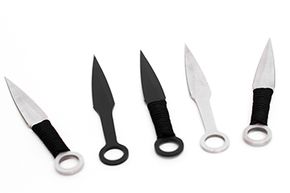Throwing Knife: Weapon of Choice
Like anyone who has tried to put together Ikea furniture without a hex wrench, knife throwers know that success, especially for beginners, depends on choosing the right tool. So before we get into how to throw, let's spend a moment to consider the qualities that make for a good throwing knife.
As hinted at in our physics section, a good throwing knife relies on the right combination of three factors, in the following order: balance, weight and length [source: McEvoy].
Advertisement
There's a bit of a chicken-and-egg relationship between knife balance and the kind of throwing you plan to do. As we mentioned in the previous section, you'll want to throw heavy-end-first, and your knife will reflect that. If balanced for handle-throwing, then a knife's center of mass is shifted toward the tip; if balanced for blade-throwing, the opposite will hold true. Some knives are balanced to be thrown either way, with the weight balanced dead-center [sources: Branton; McEvoy].
We've already seen that weight determines whether your pig-sticker packs enough punch to pierce the target, and that this heft must be balanced for throwing. A good rule of thumb is to select a blade that weighs roughly 1 ounce per inch (11 grams per centimeter) of total length (not blade length) [sources: Branton; McEvoy]. Most throwers use knives weighing more than 10 but less than 16 ounces (283 to 454 grams). If you do the math, that means a typical knife length runs from 10 to 15 inches (25 to 38 centimeters). Note that a longer knife means a slower rotation, so some experts suggest a knife of 12 to 14 inches (31 to 36 centimeters) for beginners [sources: Adamovich; AKTA; Branton; McEvoy].
It should go without saying that throwing knives should not have particularly sharp edges, especially if you plan to throw them by the blade [sources: Branton; McEvoy]. Although you will keep your fingers curled away from the blade when throwing, having a sharp edge adds nothing to the throw except the danger of cutting yourself. Remember: When it comes to sticking, it's the knife's point that matters.
As for cost, throwing knives can start in the low teens and ramp up to more than $100 apiece for custom models. Most experts advise buying the best you can afford. Cheap or poorly balanced knives can break or not perform well, leaving you frustrated and throwing off your technique [source: AKTA]. Throwing knives are often sold in sets of three or five, a worthwhile investment that can save you the fatigue and loss of focus of walking back and forth. This is important, because learning to throw a knife is all about practice, posture and finding your perfect distance.
